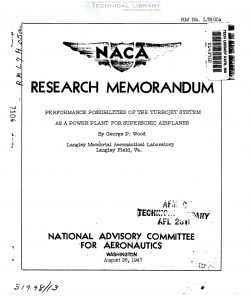naca-rm-l7h05a
- Version
- 257 Downloads
- 1.87 MB File Size
- 1 File Count
- March 14, 2017 Create Date
- March 14, 2017 Last Updated
National Advisory Committee for Aeronautics, Research Memorandum - Performance Possibilities of the Turbojet System as a Power Plant for Supersonic Airplanes

The National Advisory Committee for Aeronautics has issued
several papers that present analyses of the performance possibilities
of Jet engines. In references 1 and 2, for example, calculations of
the performance of compressor-turbine Jet—propulsion, or turboJet,
systems operating at eubsonic airplane speeds are given. In
reference 3 results of an investigation-of the performance of
continuous—flow and compression, propulsion or ramjet systems
propelling aircraft at supersonic speeds are presented. The question
naturally arises as to the potentialities and the limitations of the
turbojet system as a power plant for. airplanes at supersonic speeds.
The results obtained from analyses of the" 'turbojet system operating
at subsonic speeds, however, cannot be expected to give quantitative
information about the performance of the turbojet system operating at
supersonic speeds. Because of the difference in the compression
available from the forward speed, the optimum blower compression
ratio for operation at supersonic speeds, for example, may be quite
different from the ratio for operation at subsonic speeds.
The purpose of the present paper is to report an analytical
investigation of the turbojet system as a means of propelling
airplanes and missiles at supersonic speeds.
A comparison of the performances of the turbojet and the ram—Jet
systems at supersonic free-stream speeds is also given herein. These
two systems differ in three inherent characteristics that affect _
their performance as power plants, namely, maximum fluid, temperature,
maximum fluid pressure, and mximum cross—sectional area.
The maximum fluid temperature that can be used in the turboJet system is
limited by the mechanical, properties of the turbine blades.
The ram-Jet system, however, has no turbine, and higher maximum'fluid
temperatures can therefore be used. The maximum fluid pressure in
the ram-Jet system is limited to the pressure obtainable from ram.
| File | Action |
|---|---|
| naca-rm-l7h05a Performance Possibilities of the Turbojet System as a Power Plant for Supersonic Airplanes.pdf | Download |

Comment On This Post